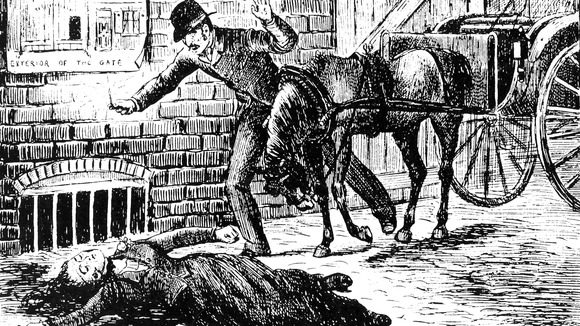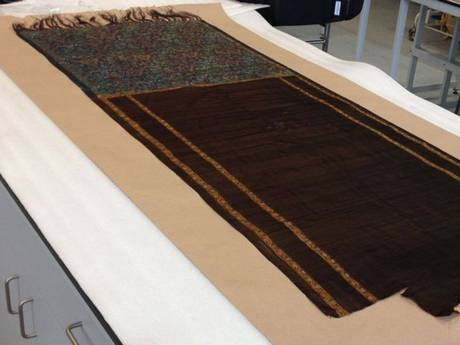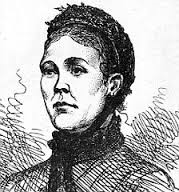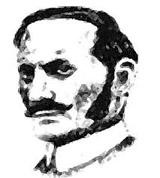 Naming Jack the Ripper
Naming Jack the Ripper
Russell Edwards
Published Tuesday 9 September 2014; £16.99
hardback
-
Identity of Jack
the Ripper finally proven 126 years after the murders
-
Victorian shawl
offers up DNA to unlock the mystery
-
DNA testing
proves conclusively that Aaron Kosminski was the killer
In 2007, businessman Russell Edwards
bought a Victorian shawl at an auction.
The shawl was large – over 7 feet
long, made of silk, obviously very old, and damaged, with pieces missing. The
shawl had been taken by a policeman from the murder scene of Jack the Ripper’s
fourth victim, Catherine Eddowes, on 30 September 1888. Since then, aside from a few years in
Scotland Yard’s Black Museum, it had been safely stored away by the direct
descendants of that policeman.
In his book, Naming Jack the
Ripper, to be published on Tuesday 9 September, Russell Edwards details the
years of dedicated historical and scientific research that has gone into
proving without doubt that Aaron Kosminski was Jack the Ripper.
His exhaustive historical research
coupled with cutting-edge DNA testing undertaken by leading forensic
geneticist, Dr Jari Louhelainen of Liverpool John Moores University, have linked
the shawl with the descendants of Kosminski and his victim. Crucially, DNA taken from blood and semen
stains on the shawl matched the descendants of both Catherine Eddowes and her
killer.
The key that began to unlock the mystery
was the shawl’s distinctive pattern – Michaelmas daisies. Russell Edwards
remembered that police and newspaper reports at the time of Catherine Eddowes’s
murder had referenced an item of clothing with a similar pattern. It was that shawl that was up for sale at a
Suffolk auction house in 2007.
The shawl’s owner told Russell that a
London policeman, Acting Sergeant Amos Simpson who was on duty the night of
Eddowes’s death, asked if he could have it for his dressmaker wife. Understandably,
Simpson’s wife reacted in horror at the thought of using a bloodstained shawl. It
was stowed safely away, never washed, and passed down from generation to
generation.
This family history could never be
definitive proof of a link to Catherine Eddowes, despite a letter confirming
its provenance. Only scientific analysis of the stains on the shawl could prove
without doubt its presence at the murder.

A newspaper picture depicting the death of Catherine Eddowes. Photo: PA
As Russell Edwards continued his
research into the story of Jack the Ripper, Dr Jari Louhelainen, Senior Lecturer
in Molecular Biology, began his painstaking examination of the shawl.
Primary analysis by Dr Louhelainen showed
the dark stains on the shawl were not just blood but were ‘consistent with
arterial blood spatter caused by slashing’. A large dark stain could, he
suggested, also be evidence of split body parts (some of Catherine Eddowes’s
organs, including her left kidney, were removed during her brutal murder). White
stains fluoresced under UV light suggesting the presence of seminal fluid.
So began the three year scientific
analysis of the shawl and the search for the descendants of Catherine Eddowes
and the man who Russell Edwards – and many others, including the police
officers who originally investigated the case and Scotland Yard -
suspected was Jack the Ripper. In the end, it was DNA coding that
confirmed the authenticity of the shawl and the identity of the killer.
Work began in earnest in Dr
Louhelainen’s laboratory on the DNA of the blood stains. Seven small segments of mitochondrial DNA,
passed down through the direct female line, were isolated from the blood stains
and matched with the DNA of Karen Miller, a direct descendant of Catherine
Eddowes. This confirmed the presence of Catherine Eddowes’s blood on the shawl.
At the same time, findings by
molecular chemist, Dr Fyaz Ismail, who tested the blue dye on the shawl using
nuclear magnetic resonance, suggested that the shawl was Russian and predates
the murders. This backed up Russell Edwards’s theory that the shawl, which
was of particularly fine quality, belonged to Kosminski and not to Eddowes, who
was unlikely to have owned such a costly item. The region of Poland where
Kosminski lived was under Russian control and would have traded with its
neighbour.
The third part of the jigsaw focussed on samples
of the seminal fluid from the shawl. Dr David Miller, Reader in Molecular
Andrology at the University of Leeds managed to find the cells from which the
DNA was isolated. All that remained was
for Russell Edwards to find a descendant of Kosminski through the female line.
The woman Russell traced, with the
help of genealogists, offered samples of her DNA to make the crucial comparison.
Seven years after Russell Edwards had bought the shawl, they finally had a
match: Dr Jari Louhelainen matched DNA from the semen stains on the shawl to the
descendant of Aaron Kosminski.
The circle is now complete. One of
the greatest unsolved crime mysteries of all time has been solved through
cutting edge science, historical research and a great deal of determination and
good fortune. Aaron Kosminski – Jack the Ripper - has been placed, once and for
all, at the scene of Catherine Eddowes’s horrific murder.
Background
Provenance of the shawl

The shawl bought by Russell Edwards in 2007
was put up for auction by the family of David Melville-Hayes, descendants of
Acting Sergeant Amos Smith who was at the murder scene. It had been kept in a box by the family
and was lent to the Black Museum at Scotland Yard before being returned to them
in 1997. Until the work led by Dr Jari
Louhelainen from 2011, the shawl had never been examined for DNA or subjected
to chemical testing for proof of age and geographical provenance.
Using a nuclear magnetic resonance instrument, Dr Fyaz Ismail,
Senior Lecturer in Medicinal Chemistry at Liverpool John Moores University,
confirmed that the shawl’s natural dye shares characteristics similar to those
he had seen before from the area around St Petersburg.
Catherine Eddowes

Catherine Eddowes was the Ripper’s fourth
victim; she died on the night of 30 September 1888, the same night as his third
victim, Elizabeth Stride. Catherine was
born in Wolverhampton in 1842. The
family moved to Bermondsey when she was about two. Orphaned in her teens, she moved back to the
Midlands and then to Norfolk before returning to London; she had a daughter and
two sons by Thomas Conway from whom she separated in 1881.
On the night of 29 September, Catherine was
arrested for drunkenness and taken to Bishopsgate Police Station at around
8.30pm. She was released at 1.00am once
she had sobered up and headed off towards Houndsditch in London’s East
End. Forty five minutes later she was found
brutally murdered in Mitre Square. She
was 46 years old.
Aaron Kosminski

Aaron Mordke Kosminski was born in Klodawa in central Poland
on 11 September 1865, the youngest of seven children – four girls and three
boys - of tailor Abram Josef Kozminski and his wife, Golda Lubnowski. Following the death of Abram, the family emigrated to the East End and it is certain that by the time of
the murders, Aaron Kosminski was living very close to the murder scenes.
The records for Aaron Kosminski
are scanty. There is a tantalizing
glimpse of him in December 1889 when he appeared in court after being arrested for
walking an unmuzzled dog in Cheapside.
Kosminksi was fined.
He reappears in 1890
living in the Mile End Workhouse where he was described as ‘destitute’ on
admission. Although discharged later
that year, he was readmitted suffering from ‘mania’ having attacked his sister
with a knife. The decision to commit him
was ‘unchallenged’ by his family.
Aaron Kosminski was on the
list of credible suspects at the time of the Ripper murders. In the mid 1890s, Kosminski was taken in by
the police to be identified by a witness who had seen him attacking one of the victims. A positive identification was made but
the witness refused to give incriminating evidence. The police had little option but to release
Kosminski into the care of his family.
On 4 February 1891 was
committed to Colney Hatch Asylum in north London. There the admission register describes
Kosminski as twenty-six years of age, Hebrew, single and whose occupation was a
hairdresser. He was transferred to
Leavesden Asylum near Watford in Hertfordshire in 1894.
Kosminksi died at
Leavesden on 24 March 1919, the cause of death, gangrene. He was buried by the Burial Society of the
United Synagogue on 27 March 1919 at East Ham Cemetery
Russell Edwards
Russell Edwards, who is married with two
children, is a 48 year old businessman.
Originally from Birkenhead, he now lives in Hertfordshire. He first got
to know the Whitechapel area in London’s East End as a student and about the Ripper
story in the early 1990s. Ten years
later, Russell started to read more and more about the case and revisited the
area where the murders had happened.
What started as an interest became, by 2007, a mission to prove the
identity of the world’s most famous murderer.
Naming Jack the Ripper is his first book.
Dr Jari Louhelainen
Dr Jari Louhelainen is
Senior Lecturer in Molecular Biology at Liverpool John Moores University, as
well as Associate Professor of Biochemistry at University of Helsinki. He has
two major lines of research – mammalian/medical genetics and forensics.
In the past Dr.
Louhelainen has worked for the University of Oxford (2005-2006), Cancer
Research UK in Leeds (2000-2005), Karolinska Institute in Sweden (1994-2000)
and the University of Helsinki, Finland (1988-1994).
Dr Louhelainen has a PhD
in Molecular Epidemiology from the Karolinska Institute in Sweden and and MSc
in Biochemistry from the University of Helsinki.
Dr Fyaz Ismail
Dr Fyaz Ismail is Senior
Lecturer in Medicinal Chemistry, Drug Design and Discovery Module Leader at
Liverpool John Moores University.
He read Chemistry and
Biochemistry at the University of Salford where he subsequently worked as a
Research Fellow; his research with Dr Neal Stuart Isaacs at The High Pressure
Unity on the ‘greening’ of the previously
highly polluting Mercaptobenzthiazole process (MBT) received the Presidential
Award from Bill Clinton for Greening the Environment. University of
Hertfordshire: Senior Lecturer in Medicinal Chemistry and Spectroscopy.
Dr Ismail was
appointed at Liverpool John Moores University School of Pharmacy &Chemistry
in 2001. He currently leads the Medicinal Chemistry Research Group, an
international team of scientists that are committed to designing, constructing,
testing developing new antimalarial compounds for global dissemination for the
control and prevention of malaria.
Dr David Miller
Dr David Miller is Reader in Molecular Andrology at the Leeds
Institute of Cardiovascular and Metabolic Medicine. His specific area of research is focussed on molecular and genetic aspects of male
infertility and reproductive function.
why husbands cheat
read I cheated on my girlfriend
read
go which is better chalis or viagra
spyware apps for android
link cell spy monitoring software
sildenafil citrate 130mg
tadalafil prednisolone 20mg
2016 viagra coupon
site coupon for free viagra
manufacturer coupons for prescription drugs
site cialis coupons and discounts
coupon for bystolic
click forest patient assistance
naprosyn 750 mg
click naprosyn jel nedir
allotment
click allo allo
ventolin prospecto
click ventolini cali
aborted babies
click elective abortion
free printable cialis coupons
selba.ca discount coupons for cialis
what is an abortion clinic
rftrack.net where to do abortion